Since its debut, Google’s Imagen series has pushed the boundaries of AI-driven text-to-image generation. Imagen 3 set a high bar with its ability to generate high-resolution, detailed images from complex prompts. However, the newly released Imagen 4 represents a significant leap forward in multiple dimensions—image quality, text accuracy, speed, and integration.
This article compares Google Imagen 3 and Imagen 4 in detail, highlighting what makes Imagen 4 a game-changer for creatives and businesses in 2025.
Differences Between Google Imagen 3 and Imagen 4
Overview of Google Imagen 3
Imagen 3, launched in late 2024, was Google DeepMind’s flagship text-to-image diffusion model. It combined advanced natural language understanding with high-resolution image synthesis (up to 1024×1024 pixels by default, with up-sampling options) (Google DeepMind, 2024).
Key features of Imagen 3 included:
-
High photorealism with detailed textures and vibrant colors
-
Strong adherence to complex, multi-object prompts
-
Improved coherence and fewer artifacts compared to earlier models
-
Support for multiple artistic styles, from impressionistic to hyper-realistic
-
Responsible AI safeguards to minimize harmful outputs
Imagen 3 was widely adopted in creative sectors such as advertising, gaming, and design for its ability to visualize abstract ideas and produce compelling visuals quickly.
What’s New in Google Imagen 4
Imagen 4, unveiled at Google I/O 2025, advances upon Imagen 3 with several key improvements (TechCrunch, 2025):
-
Higher resolution support: Up to 2K resolution for finer detail capture
-
Photorealistic texture fidelity: Enhanced rendering of complex surfaces like fabrics, water droplets, and animal fur
-
Typographical accuracy: Breakthroughs in rendering readable, precise text within images
-
Speed: Introduction of a “fast variant” capable of generating images up to 10x faster than Imagen 3
-
Broader aspect ratio flexibility: Social media-friendly formats like 9:16 reels and ultra-wide banners
-
Deeper integration: Embedding within Google Workspace apps (Slides, Docs, Vertex AI) for seamless creative workflows
These advancements make Imagen 4 not just a technical upgrade but a practical tool for professional and everyday creators.
Image Quality and Photorealism Comparison
The Strengths of Imagen 3

Imagen 3 was praised for its ability to generate vivid, realistic images that closely matched user prompts. For example, it could depict a “felt puppet diorama scene of a tranquil forest clearing” with soft washes of color and detailed character interactions.
Imagen 4 Improvements

Prompt: Capture an intimate close-up bathed in warm, soft, late-afternoon sunlight filtering into a quintessential 1960s kitchen. The focal point is a charmingly designed vintage package of all-purpose flour, resting invitingly on a speckled Formica countertop. The packaging itself evokes pure nostalgia: perhaps thick, slightly textured paper in a warm cream tone, adorned with simple, bold typography (a friendly serif or script) in classic red and blue “ALL-PURPOSE FLOUR”, featuring a delightful illustration like a stylized sheaf of wheat or a cheerful baker character. In smaller bold print at the bottom of the package: “NET WT 5 LBS (80 OZ) 2.27kg”.
Focus sharply on the package details – the slightly soft edges of the paper bag, the texture of the vintage printing, the inviting “All-Purpose Flour” text. Subtle hints of the 1960s kitchen frame the shot – the chrome edge of the counter gleaming softly, a blurred glimpse of a pastel yellow ceramic tile backsplash, or the corner of a vintage metal canister set just out of focus. The shallow depth of field keeps attention locked on the beautifully designed package, creating an aesthetic rich in warmth, authenticity, and nostalgic appeal.
Imagen 4 takes this further by capturing hyper-fine details such as individual water droplets on dandelion seeds or the weave of denim fabric. The model’s ability to render subtle textures and lighting nuances results in images that appear indistinguishable from high-quality photographs (The Verge, 2025).
Visual Comparison
A popular comparison shared on Reddit shows an iconic Mount Fuji scene rendered by both models. Imagen 3’s version is artistic and soft, while Imagen 4’s is sharper, more detailed, and visually striking.
Typography and Text Rendering Improvements
The Typographical Challenge
One of the biggest limitations of Imagen 3 and many AI image generators was poor text rendering. Text often appeared distorted or unreadable, limiting the model’s utility for marketing materials, comics, and branding.
Imagen 4’s Breakthrough
Imagen 4 introduces a refined text rendering system capable of producing crisp, legible typography even in small fonts or complex layouts. This enables the creation of images with embedded text, such as posters, greeting cards, and comic speech bubbles without manual correction.
Practical Impact
This advancement is a boon for marketers and designers who can now generate assets with perfect logos, slogans, and calls to action directly from AI, streamlining workflows and reducing costs.
Speed and Performance Enhancements
Imagen 3 Performance
While Imagen 3 delivered high-quality images, generation times could be several minutes per image, limiting rapid iteration.
Imagen 4 Fast Variant
Google announced a fast variant of Imagen 4 that can generate images up to 10 times faster than Imagen 3, enabling near real-time creativity.
Workflow Benefits
This speed allows designers to test dozens of concepts quickly, marketers to produce timely campaign visuals, and educators to create engaging materials on demand.
Integration and Accessibility
Standalone vs Integrated Use
Imagen 3 was primarily accessed via APIs and research demos. Imagen 4, however, is integrated into Google Workspace tools like Slides, Docs, and Vertex AI, making it accessible within familiar productivity environments.
Democratizing Creativity
This integration lowers the barrier for non-experts to create professional-grade visuals, expanding AI’s reach beyond specialized users to everyday business and education sectors.
Use Cases and Industry Impact
-
Advertising: Faster, more precise ad creative production with embedded text
-
Publishing: Automated illustration of books and marketing collateral
-
Education: Creation of detailed, accurate visuals for teaching materials
-
Entertainment: Storyboarding and concept art with photorealistic detail
-
Small Businesses: Affordable, high-quality marketing assets without design teams
Imagen 4’s improvements enable broader adoption across industries, particularly in regions like Africa where access to professional design resources may be limited (Africa Tech Review, 2025).
Challenges and Limitations
Despite advances, Imagen 4 has limitations:
-
Cultural Nuances: AI may misinterpret local idioms or symbolic imagery without precise prompts.
-
Multilingual Text: While improved, text rendering in less common languages or scripts may require further refinement.
-
Ethical Concerns: Risks of misuse, copyright infringement, and misinformation persist.
-
Hardware Requirements: High-speed internet and cloud access are needed for optimal performance.
Future Outlook
Google plans to expand Imagen 4’s capabilities with:
-
3D model generation
-
Video integration (in concert with models like VEO 3)
-
Augmented and virtual reality content creation
These developments promise to further revolutionize creative workflows in the coming years.





